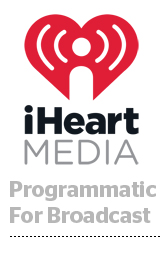 iHeartMedia media revealed Wednesday that it’s bringing programmatic, real-time radio ad-buying to terrestrial radio, powered by Jelli’s cloud-based ad platform. The news means that advertisers and agencies will soon be able to access iHeartMedia’s inventory in private exchanges for broadcast radio.
iHeartMedia media revealed Wednesday that it’s bringing programmatic, real-time radio ad-buying to terrestrial radio, powered by Jelli’s cloud-based ad platform. The news means that advertisers and agencies will soon be able to access iHeartMedia’s inventory in private exchanges for broadcast radio.
As part of the unveil, iHeartMedia and Katz Media Group, a firm that does media representation for radio and TV, will launch Expressway from Katz later this year, to extend the solution to the broader radio industry. The iHeartMedia product will be a private network solution at the outset, whereas Expressway from Katz will be spot-focused, i.e., focused on individual stations.
“We’re sitting on a treasure trove of data, and we know that advertisers are too,” said Brian Kaminsky, COO at iHeartMedia. “The entire industry is moving toward using data to evaluate what they buy and how it performs and to optimize in real time what they do.”
iHeartMedia is rolling Jelli’s hardware and software into its radio stations, a process Kaminsky said will take four or five months. Once activated, iHeartMedia will make a certain amount of inventory available. “Not a lot,” according to Kaminsky, “but a good sample set across all our markets, all of the day parts and all of the stations. The amount of inventory going in will start relatively small, based upon the demands iHeartMedia observes.”
Kaminsky said he didn’t anticipate that 100% of iHeartMedia’s inventory would ever be available. “But I wouldn’t say that there will ever be a limit on the volume or the nature of quality of the inventory we put in,” he added.
Michael Dougherty, CEO of Jelli, said that radio finally has a place in programmatic advertising. The release noted media agencies like ZenithOptimedia, Universal McCann and Horizon Media as the first known agency partners to trial the solution.
“Radio has always been thought of as legacy media, and iHeartMedia is doing a very progressive job of trying to leverage the enormous reach of their platform, marrying it with new technology to provide advertisers a platform to play in the same sandbox as traditional digital media,” Horizon Media CEO Bill Koenigsberg told AdExchanger.
Triton Digital has been playing in the digital radio programmatic space for two years, but iHeartMedia’s launch marks the first automated, real-time platform for terrestrial radio. Radio is a 17-billion-dollar market in the US, according to Dougherty, and about 90% of that is broadcast radio.
iHeartMedia, formerly Clear Channel, is the largest radio company in the US, reaching about 245 million people a month.
Through the deal, Jelli’s platform will act as an SSP and an exchange platform for iHeartMedia as well as for the eventual industry exchange from Katz. Jelli will manage inventory through its platform and will install an ad server at every iHeartMedia radio station in the US – of which there are around 850.
Jelli will report on all of the buys in real time when ads run on air. If an ad is running across the country on 400 radio stations, for example, Jelli’s platform does the calculation of audience delivery. As part of that calculation, Jelli partners with Nielsen, which acts as the data source for audience measurement.
iHeartMedia will leverage first- and third-party data for all types of targeting, including weather and traffic patterns, purchase behavior, consumer trends and music-based psychographics groups.
Though Koenigsberg couldn’t reveal exactly how Horizon planned to use the solution for targeting, as the agency has competing clients, he said that Horizon is moving away from buying drive time or day parts to buying audiences. There could, however, be some kind of real-time messaging with regard to drive time, he added, like a call-to-action message that Horizon could track on an hourly basis, based on KPIs.
“iHeartMedia is trying to figure out the technology that will allow us to adjust on a real-time basis,” he explained. “We then have to marry that with whatever our particular brand KPIs are. We’ll mold and optimize our media buys based on tracking, time period, day part, messaging and other KPIs.”
Once the solution is fully realized, Kaminsky predicts new avenues for radio, the key to which, he added, is a laser-sharp focus on increasing ROI.
“According to a Nielsen study that was done late last year, the return for radio is six to one for every dollar invested,” he said. “That’s huge. By creating a platform that allows advertisers to overlay the data and insights that they can in other media, matched with the return they’re going to get, we believe we’re going to drive a tremendous amount of business to the radio agency.”












